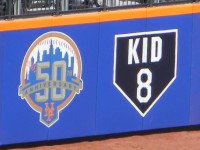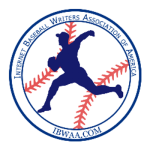Nolan Ryan

Going into the 2016 season, there is one fear each and every Mets fan has. We dare not speak its name, but that doesn’t change the fact that it’s still present. That fear is that a pitcher will get seriously injured.
Looking at this year’s list of pitchers who could befall the dreaded “Verducci Effect,” Noah Syndergaard headlines that list. If Syndergaard was to suffer a season ending injury requiring Tommy John surgery? it would greatly hinder the Mets chances of winning not only the World Series, but also making it to the postseason. It’s something that not just Mets fans fear, but as Anthony DiComo of MLB.com reports, Syndergaard fears it also:
I’ve thought about it quite a bit. But I trust myself to put my body in the right situations to be able to perform at a healthy level.
The fear is justified. Syndergaard threw 65.2 innings more last year. He throws over 95 MPH more than anyone in the game. He’s working to add the fabled Warthen Slider to his already dominant repertoire. Name a risk factor for UCL years requiring Tommy John surgery. Syndergaard meets most if not all of them.
One risk factor not readily discussed is the team he plays for. Look at the projected Mets rotation when healthy: Matt Harvey, Jacob deGrom, Noah Syndergaard, Steven Matz, and Zack Wheeler. Put aside Syndergaard for a moment. What do the other four have in common? They are all hard throwing pitchers under the age of 30 who have already had Tommy John surgery.
Go outside this group. Since Warthen took over as the Mets pitching coach, the following homegrown Mets have sustained arm injuries: Jon Niese (shoulder), Dillon Gee (shoulder), Jeremy Hefner (two Tommy John surgeries), Rafael Montero (shoulder), Bobby Parnell (Tommy John), Josh Edgin (Tommy John), Jack Leathersich (Tommy John). There are more, but you get the point.
Now, is this an organizational problem since Warthen took over, or is it just bad luck? Could this all have been avoided? Back in the 60’s and 70’s the Mets developed pitchers like Tom Seaver, Jerry Koosman, Nolan Ryan, and Jon Matlack. These pitchers threw more innings than the pitchers today, and yet, Matlack was the only one of this group that suffered an arm injury.
In the 80’s, the Mets had Dwight Gooden, Ron Darling, Sid Fernandez, Rick Aguilera, Randy Myers and David Cone. Of this group, only Doc and Cone had arm issues. It should be noted that Doc had many other issues as well, and Cone’s problem was an aneurysm later in his career.
In the 90’s, Generation K was a bust, and the Mets haven’t developed the caliber of starting pitchers like they have in the past until now. However, this generation seems to befall injuries far more often than their predecessors. Is it organizational? Is it bad luck? Is it preparation? For his part, Harvey wonders what if:
I think now, there are things I could have done better in high school or in college to maybe prevent it. But I don’t know. I’m not saying [Syndergaard] works that much harder than everybody else, because we all work hard. I think as time progresses, guys pay more attention to stretching the shoulder, strengthening the shoulder. If I could go back — I don’t know if this would’ve prevented me from having [surgery], but if I could go back and really do 20 extra minutes of stretching and arm care, you never know what could happen.
That’s the thing. We really don’t know why one guy suffers elbow and shoulder injuries while others don’t. Is it preparation? Is it good genes? Is it just good luck? Much time, energy, and money has been spent on this issue, and yet pitchers still get injured. Pitchers get injured despite teams doing everything in their power to try to prevent it.
It will help Syndergaard being in a clubhouse with players who have had Tommy John surgery. They each will have advice for him on why they suffered the injury and what they could’ve done differently. More importantly, Syndergaard appears to be a hard worker who takes the health of his arm very seriously. There is no doubt he is doing everything he can do to avoid the dreaded Tommy John surgery.
Based on what we’ve seen, if anyone can avoid it, it’s him.
Editor’s Note: this article was first published on metsmerizedonline.com

Every single one of us has our favorite players. Growing up, I loved Gary Carter. If I had a blog back in 1997, it would’ve been named ElectGaryCartertotheHallofFameNow.com.Finally, in 2003, The Kid was finally elected in the Hall of Fame. I wanted him to go in as a Met and for him to have his number retired by the team.
There would be controversy over his cap. To understand the controversy, we have to go back in time a bit. There was a time that players were not selecting caps due to the team they felt most closely aligned or where they accomished the most. No, players were selecting caps based upon financial incentives.
Dave Winfield received $1 million to wear a Padres cap on his Hall of Fame plaque when he was inducted in 2001. Winfield going into the Hall as a Padre wasn’t an egregious choice. He started his career there, and he played eight years there as opposed to nine with the Yankees. He did have better numbers with the Yankees, but he was also treated awfully by them. Steinbrenner dubbed him Mr. May to deride his production in a pennant race. Steinbrenner hired gamblers and private investigators to “dig up dirt” on Winfield to get out from under the contact. So no, it’s not surprising Winfield chose the Padres cap and the $1 million.
Winfield wasn’t egregious, but it was the sign of a larger problem. That problem would come to a head with Wade Boggs. There were rumors that Boggs negotiated in his contract that he would enter the Hall of Fame as a Tampa Bay Devil Ray. It forces the Hall of Fame’s hand, and they began the process of selecting player caps, even if it was against a player’s wishes. As we saw with Andre Dawson, it’s a move that benefitted the defunct Montreal Expos.
On the one hand, it’s a move that had to be made. You couldn’t have players and teams negotiating this away in one year contracts towards the end of a player’s career. The Hall of Fame does have some responsibility to preserve history. On the other hand, the Hall of Fame has overstepped its bounds a bit. Remember they did allow Reggie Jackson to enter the Hall of Fame as a Yankee (5 years) as opposed to the Athletics (10 years). They allowed Nolan Ryan to enter the Hall of Fame as a Ranger (5 of his worst years) instead of an Astro (9 years) or an Angel (8 years).
Carter played 12 years for the Expos, and 5 with the Mets. Based on the Jackson/Ryan standard he should’ve had his choice even if Carter was an Expo through and through. However, Carter wanted to go in as a Met. The Hall of Fame decided he would go in as the first Montreal Expos; a decision Carter did not object.
Unfortunately, the decision cost him. The Expos moved to Washington a year and a half after his induction. The franchise almost immediately unretired the number of their first Hall of Famer. Also, it cost Carter his chance of the Mets retiring his number 8.
As we saw with Mike Piazza, the Mets have set an exceedingly high standard for retiring numbers. For their players, the Mets have reserved that honor for players who have entered the Hall of Fame wearing a Mets cap. With one decision made by the Hall of Fame, not by Carter, Carter was cheated of his chance to have his number retired by the Mets. Sadly, even if the Mets reverse course, the day honoring Carter will be melancholy with his untimely death at the all too young age of 57.
If Carter isn’t there to enjoy the honor, I believe the moment has passed. As much as I may have wanted it one day, I don’t think the time is now. If the Carter family feels differently, I certainly would change my tune.

Before looking at my ballot, please keep in mind that the IBWAA already elected players on the current ballot. This includes Mike Piazza and Jeff Bagwell I would’ve voted for them because I don’t play the steroids guessing game.
I also would’ve voted for Tim Raines, but he already received the necessary 75% from the IBWAA. Raines was the second best lead off hitter of all time, and frankly I haven’t seen a good reason to withhold your vote for him. Furthermore, even if the vote doesn’t count towards the BBWAA Hall of Fame ballot, I didn’t want to incur the wrath of Jonah Keri.
As a reminder, here are the criteria I use in Hall of Fame voting. As such, I did not vote for Barry Bonds or Roger Clemens. With that said, here are the players on my ballot:
Junior might’ve been the best player in my lifetime, at least when he was launching home runs in the old Kingdome. When you look at his WAR, he’s only behind Willie Mays, Ty Cobb, Tris Speaker, and Mickey Mantle. If you’re the fifth best ever at a position, you deserve to be in the Hall of Fame.
The average Hall of Fame SS has a career WAR of 66.7, a peak WAR (also known as WAR7) of 42.8, and a JAWS score of 54.7. Trammell’s numbers are 70.4/44.6/57.5. Translation, he’s one of the top SS in major league history. Keep in mind, he is a .285/.352/.415 career hitter with four Gold Gloves, six All Star Game appearances, and three Silver Sluggers.
On top of that, he hit .333/.404/.588 in the postseason. He was also the 1984 World Series MVP. It’s his last year on the ballot. He deserves to be elected.
The narrative on Walker is he’s a Coors Field creation. I get it because he hit an amazing .381/.462/.710 at Coors Field. Those are insane numbers.
Look at it this way. Walker has hit .278/.370/.495 on the road in his career. In his six years with the Expos at the beginning of his career, he hit .281/.357/.483. Reggie Jackson, who was one of the top RF all time, hit .262/.356/.490. On top of this, Walker was a five time All Star with seven Gold Gloves and two Silver Sluggers. He was the 1997 NL MVP. If you’re comparable to Reggie Jackson, you’re a Hall of Famer.
If you look over Kent’s career, his WAR, WAR7, or JAWS doesn’t match-up. The average for second baseman is 69.3/44.4/56.9. Kent was only 55.2/35.6/45.4. He fell short on those terms, but I voted for him anyway.
The issue is Kent was not a good defensive player, but he was a terrific hitter. Amongst second baseman, he’s hit the most homeruns, fourth most doubles, third highest RBI, and the second highest slugging percentage. Overall, he was a .290/.356/.500 hitter with 377 homeruns. He was the second best offensive second baseman to Rogers Hornsby. To me, being the second best offensively at his position was barely sufficient for me to vote for him.
Look, I think postseason excellence should be considered in Hall of Fame voting. Schilling was 11-2 with a 2.23 ERA, a 0.968 WHIP, and a World Series MVP. Bloody sock or not, that is as impressive as it gets.
With that said, I didn’t vote for Schilling due to his postseason success. I voted for him due to his regular season success. Schilling was 216-146 with a 3.46 ERA. 1.137 WHIP, a 8.6 K/9, and a 4.38 K/BB ratio. His K/BB is second best all time. His stats are good enough for a 127 ERA+, which is the same as Tom Seaver. His WAR is 79.9, which is higher than the average WAR for a Hall of Fame pitcher.
Postseason success or not, Curt Schilling is a Hall of Famer.
Speaking of career WAR, Mussina’s career WAR of 83.0 is actually higher than Schilling’s.
Mussina was 270-153 with a 3.68 ERA and a 1.192 WHIP. Those are remarkable numbers considering he pitched his entire career in the AL East during the steroid era. It’s unsurprising he would have an ERA+ of 123. That’s better than Juan Marichal and Nolan Ryan. Mussina bomgs in the Hall of Fame.
Other Notables
I didn’t vote for Edgar, who is a career .312/.418/.515 hitter. My vote for him only partially had to do with him being a DH.
I do believe there is room for a DH to be in the Hall of Fame. No matter how they are characterized, there are two right now: Frank Thomas and Paul Molitor. As these are the only two DH’s in the Hall of Fame, I’m judging Edgar against the two of them.
Edgar had a 147 OPS+, 147 wRC+, .415 wOBA, and a 68.3 WAR.
Thomas had a 156 OPS+, 154 wRC+, .416 wOBA, and a 73.7 WAR.
Molitor had a 122 OPS+, 122 wRC+, .361 wOBA, and a 75.4 WAR.
Now, Thomas and Molitor had the magic numbers. Thomas hit over 500 homeruns. Molitor had over 3,000 hits. Now, this isn’t dispositive, but it counts for something. Molitor also has postseason success hitting .368/.415/.615. He won the 1993 World Series MVP.
I bring this up because Edgar was a better hitter. Every stat but WAR is in Edgar’s favor. Edgar averaged a 3.79 WAR per year to Molitor’s 3.59 per year, so in that respect Edgar is again better. However, by no measure is Edgar better than Thomas. Thomas is better than Edgar in every stat.
Now, normally, I would say Edgar falls in line between Thomas and Molitor, so let him in. However, we’ve only had the DH since 1973. That’s only 42 years, or 27 years (10 year career with five year waiting period) of DH’s even being eligible for the Hall of Fame. With that in mind, I look at Thomas, and not the mean, as the standard.
No, I don’t think it’ll be a travesty if Edgar is elected to the Hall of Fame. Over time as I see better arguments for his inclusion, I may change my mind. However, at this time I think Edgar falls just short for me.
In response to an anticipated counter-argument, no, I don’t think it’s hypocritical that I voted for Kent due to his bat. While I do think defense should count, I have Kent credit for being the second best offensive second baseman ever. As a DH, all Edgar does is hit. Using the same standards, he would have to be the second best hitter ever. He’s clearly not that.
So for right now, I left Edgar off my ballot.
Billy Wagner
I’ll readily admit I’m a fan of Billy Wagner. I respect him. He was awesome. You should read up on him to learn about his perseverance. I really wanted to vote for him, but I didn’t.
Sure, there are amazing stats in his favor. Wagner has the most ever saves for a left handed pitcher. He has a career 2.31 ERA, 0.998 WHIP, and a 11.9 K/9. They are impressive numbers. What’s not impressive is his 28.1 career WAR. That’s lower than Tom Gordon, who is off the ballot, and Lee Smith, who last year received 29.9% in the voting last year.
Overall, I wanted to vote for Wagner on a personal level. However, when the people who are better than you aren’t in the Hall, you shouldn’t be either.
Trevor Hoffman
This was an easy name to leave off the ballot. Looking over the career stats, the only thing Hoffman has over Wagner is his saves total.
Like Wagner, Hoffman’s WAR falls short. Hoffman’s WAR was 28.4. Essentially, you’d be voting for him because he had the highest save total ever when he retired. If that wasn’t good enough for Lee Smith, it shouldn’t be enough for Trevor Hoffman.
Synopsis
Overall, even if this doesn’t count towards the BBWAA vote, I took this seriously, and I tried to justify my votes. Admittedly, Kent was my weakest vote. I still think someone could change my mind on Edgar. I don’t see myself voting for a reliever until Mariano Rivera hits the ballot.